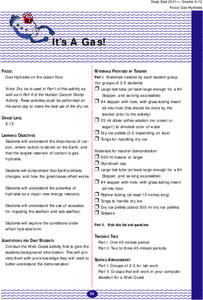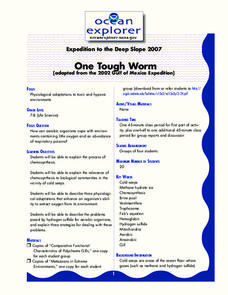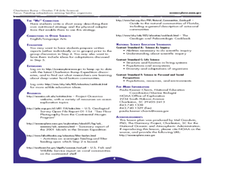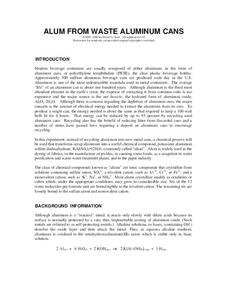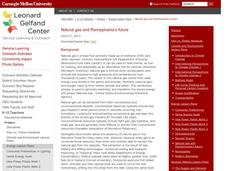Curated OER
What's the Big Deal?
Young scholars define terms and describe where they are found and formed. In this methane lesson students complete an activity and describe ways in which methane hydrates impact our lives.
Curated OER
It's a Gas!
High schoolers explore the conditions under which hydrates form. They use the Internet to access information and conduct experiments to examine how the greenhouse effect works.
Curated OER
Entering the Twilight Zone
Students describe major features of cold seep communities and list organisms that are found in these communities. In this water habitat instructional activity students examine trophic levels, describe the process of chemosynthesis and...
Curated OER
The Big Burp: Where's the Proof.
High schoolers explore the Cambrian explosion and Paleocene extinction events. In this climate change instructional activity, students read articles to link evidence they find to extinction and climate change. Links to the articles are...
Curated OER
One Tough Worm
Young scholars explain the process of chemosynthesis and its relevance to biological communities. In this investigative lesson students discuss chemosynthetic communities, then in groups they are assigned a species and are to calculate...
Curated OER
Life is Weird
Students study the organisms that are found in cold seeps and see how they interact with each-other. In this biological organism lesson students describe the major features of cold seeps and the process of chemosynthesis.
Curated OER
Cement and Concrete Engineering
Students explain the components of the engineering design process. In groups, they identify the materials that make concrete and practice curing cement using the various methods available. They develop a graph showing the amount of...
Curated OER
Basic Needs of Living Things - Lesson Two
Fourth graders study and identify the basic needs of a variety of organisms. Terrariums and aquariums are used to demonstrate what plants, animals, and fish need to stay alive. These two classic models are used to effectively convey what...
Curated OER
Harvesting Hope: The Story of Cesar Chavez
Learners identify productive resources that are important to migrant workers. For this lesson on resources, students give examples of natural resources, human resources and capital resources that apply to migrant workers. This lesson has...
Normal Community High School
Golf Ball Lab
The first golf balls were made of wood and would only last for a few games. Modern golf balls last a lot longer but they don't float. The presentation provides the directions for a lab to determine the minimum amount of salt needed to...
Curated OER
Pronoun Shift
Having problems with shifty pronouns? The 10 prompts on this activity challenge young grammarians to recognize pronoun shifts and correct those sentences that contain errors.
Curated OER
How Am I Supposed to Eat THAT?
Students explain nutritional strategies of benthic organisms.They describe nutritional strategies of benthic organisms and describe these physical characteristics.
Curated OER
Chemistry Module 5 - Specifications
While this resource does not provide problems for chemistry learners to solve, it outlines skills that they should have and concepts that they should grasp. Topics include thermodynamics, periodicity, redox equilibria, transition metals,...
Curated OER
Fabulous Felines
Students explore basic needs through discovering that pets and people need very similar things. They will play matching games, sing songs, read books, and discuss the needs of people and animals.
Curated OER
Predicting the pH of Salt Solutions
A single page provides you with lecture notes for your lesson on hydrolysis. Introduce your chemistry class to Bronsted-Lowry theory by explaining the hydrolysis of acidic cations and basic anions. Show them how the resulting pH can be...
Chymist
Alum from Waste Aluminum Cans
Turn aluminum cans into pickles! An engaging experiment has learners chemically change aluminum into a substance with many purposes including the manufacture of pickles. After performing the chemical conversion, the experimenters verify...
NOAA
Importance of Deep-Sea Ecosystems – How Diverse is That?
When judging diversity of an ecosystem, both species evenness and species richness must contribute. After a discussion of diversity and a guided example using the Shannon-Weaver function, scholars use the same function on two other...
Curated OER
Hot Rocks
Students demonstrate that setting of plaster and cement is a change, which involves a release of heat energy, use data collected experimentally to construct comparison graphs and analyze the graphs to make predictions about future...
Curated OER
Exothermic Rehydration of Gypsum
Students observe exothermic reactions in the lab using plaster. In this chemistry lesson, students collect data from their experimental set up every five minutes. They explain the different stages in the hardening of plaster.
Curated OER
Using Soap Foam to Alter the Density of Plaster of Paris
Students determine the density of Plaster of Paris that has been prepared with a foam generated from dishwashing liquids and shampoo.
Curated OER
WS 7.2 Kinetic Theory-Temperature and Volume
In this kinetic theory worksheet, students answer questions about kinetic energy, they calculate volumes of gases at STP, they answer questions about temperature and they convert from one unit of temperature to another.
Smithsonian Institution
Watching Crystals Grow
Amazing science can sometimes happen right before your eyes! The class gets cozy as they watch crystals grow. They use Epsom salts, rocks, and food coloring to create crystals. They'll observe the entire process, documenting every step...
Curated OER
Chemosynthesis for the Classroom
Explorers set up Windogradsky columns with local mud so that they can culture microorganisms. After three and six weeks they make observations of the mud and the organisms growing in it. In this way they observe succession and relate...
Carnegie Mellon University
Natural Gas and Pennsylvania’s Future
Beginning with a general discussion about natural gas, methane, and hydrocarbons, a few videos and diagrams are projected to support the lecture. Individuals participate in a brief activity by drinking juice through a straw, and then...



